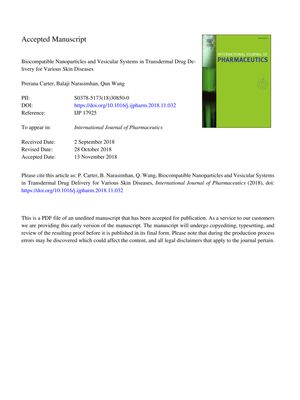Biocompatible Nanoparticles and Vesicular Systems in Transdermal Drug Delivery for Various Skin Diseases
November 2018
in “
International Journal of Pharmaceutics
”
biocompatible nanoparticles vesicular systems transdermal drug delivery alopecia psoriasis wound healing melanoma stratum corneum nanocarriers liposomes transfersomes ethosomes niosomes lipid nanoparticles polymeric nanoparticles iontophoresis ultrasound magnetophoresis skin retention stem cell-based regenerative medicine nanoparticles skin diseases hair loss skin barrier drug carriers physical methods skin treatment stem cell therapy

TLDR Nanoparticles improve drug delivery through the skin but more research is needed on their long-term effects and skin penetration challenges.
The document from 2019 reviews the use of biocompatible nanoparticles and vesicular systems in enhancing transdermal drug delivery (TDDS) for skin diseases such as alopecia, psoriasis, wound healing, and melanoma. It discusses the challenges of skin penetration, particularly the stratum corneum, and the potential of various nanocarriers like liposomes, transfersomes, ethosomes, niosomes, lipid nanoparticles, and polymeric nanoparticles to improve drug delivery. The review highlights the importance of nanoparticle characteristics such as size, shape, charge, and surface modification in drug delivery effectiveness. It also explores physical methods like iontophoresis, ultrasound, and magnetophoresis to increase drug penetration. Specific studies are mentioned, including the use of nanoparticles for enhanced skin retention and treatment efficacy in psoriasis and alopecia, as well as their role in wound healing and stem cell-based regenerative medicine. The document concludes that nanoparticles show promise in TDDS but acknowledges the need for further research to understand their long-term effects and to overcome challenges like limited skin penetration and inter-subject variation.










